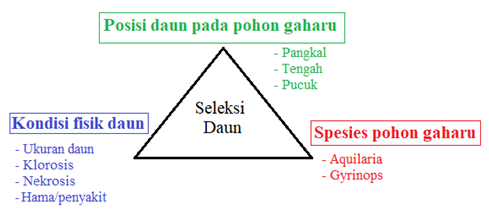
Mini-review Teknologi Produksi Teh Herbal Gaharu
Abstract
Agarwood tea is a prospective herbal tea product in the Indonesian marketplace. This product was made from agarwood trees, especially Aquilaria and Gyrinops genera. Agarwood leaves were the primary raw material of agarwood tea products. The leaves processing method into herbal tea products has adopted the conventional tea production method. This method has an essential contribution to maintaining the quality of agarwood tea products. This mini-review emphasizes the importance of systematic procedure and its effect on agarwood tea production technology. Agarwood tea production started with the standardization of raw material preparation. Raw material selection and sterilization were the essential procedure at this stage. Agarwood tea production after raw material preparation involves three steps: drying, chopping, and oxidizing. Dried leaves could produce agarwood tea with more robust characteristics than fresh leaves. Chopping the leaves is essential for agarwood tea product packaging. Oxidizing the leaves could produce agarwood tea with a better tannin concentration. It could be concluded that leaf preparation, drying, chopping, and oxidizing the leaves is an essential processing technology for agarwood leaves to produce a good quality tea.
Keywords
Full Text:
PDFReferences
Adam, A. Z., Lee, S. Y., & Mohamed, R. (2017). Pharmacological properties of agarwood tea derived from Aquilaria (Thymelaeaceae) leaves: An emerging contemporary herbal drink. Journal of Herbal Medicine, 10(2017), 37–44.
Adrianar, N., Batubara, R., & Julianti, E. (2015). Value of Consumers Preference Towards To Agarwood Tea Leaves (Aquilaria malaccensis Lamk) Based on The Location Of Leaves In The Trunk. Peronema Forestry Science Journal, 4(4), 12–16.
Akhtar, S., Khan, F. A., Ali, J., & Javid, B. (2013). Chemical Composition and Quality Comparison of Different Branded and Non-brander Black Tea Samples Available in the Local Market of Peshawar Deapartment of Plant Breading and Genetic ,. American-Eurasian J. Agric. & Environ. Sci., 13(9), 1290–1292.
Batubara, R., Hanum, T. I., Handika, A., & Affandi, O. (2020). The screening of phytochemical and antioxidant activity of agarwood leaves ( Aquilaria malaccensis ) from two sites in North Sumatra , Indonesia. Biodiversitas, 21(4), 1588–1596.
Batubara, R., Hanum, T. I., Risnasari, I., Ginting, H., & Lubis, L. A. (2018). Antioxidant Activity and Preferences Test of Agarwood Leaves Tea (Aquilaria malaccensis Lamk) Based on Leaves Drying Methods. Proceedings of BROMO Conference, 159–163. https://doi.org/10.5220/0008359101590163
Batubara, R., Hanum, T. I., & Surjanto. (2018). Phytochemical and tannin content in two species of agarwood leaves from Mandailing Natal Regency North Sumatera Province Phytochemical and Tannin Content in Two Species of Agarwood Leaves From Mandailing Natal Regency North Sumatera Province. AIP Conference Proceedings, 2049(030009), 1–5.
Batubara, R., Surjanto, & Purba, M. (2018). Keamanan Teh Gaharu (Aquilaria malaccensis Lamk) dari Pohon Induksi Terhadap Toksik Oral. Wahana Forestra: Jurnal Kehutanan, 13(1), 1–11. https://doi.org/10.31849/forestra.v13i1.1399
Deb, S., & Jolvis Pou, K. R. (2016). A Review of Withering in the Processing of Black Tea. Journal of Biosystems Engineering, 41(4), 365–372.
Etheridge, C. J., & Derbyshire, E. (2019). Herbal Infusion and Health a Review of Findings from Human Studies Mechanisms and Future Research Direction. Nutrition & Food Science. https://doi.org/10.1108/NFS-08-2019-0263
Farakte, R. A., Yadav, G., Joshi, B., Patwadhan, A. W., & Singh, G. (2016). Role of Particle Size in Tea Infusion Process. International Journal of Food Engineering, 12(1), 1–16.
Ginting, R. B., Batubara, R., & Ginting, H. (2015). Tingkat Kesukaan Masyarakat Terhadap Teh Daun gaharu (Aquilaria mallacensis Lamk.) Dibandingkan Teh Lain yang Beredar Di Pasaran. Peronema Forestry Science Journal, 4(3), 214–217.
Kamaluddin, M. T., Yuliarni, Y., Agustin, Y., Parisa, N., Hidayat, R., Wahyuni, T., Yuliana, C., & Perryanis, P. (2017). Efek Sedativa dan Kebugaran Teh Celup Daun Gaharu (Aquilaria malaccensis L). Jurnal Jamu Indonesia, 2(3), 114–119.
Karsiningsih, E. (2016). Analisis Kelayakan Finansial dan Strategi Pengembangan Teh Gaharu di Kabupaten Bangka Tengah (Studi Kasus: Teh Gaharu “Aqilla” Gapoktan Alam Jaya Lestari). AGRARIS: Journal of Agribusiness and Rural Development Research, 2(2), 143–151.
Kaur, A., Kaur, M., Kaur, P., Kaur, H., Kaur, S., & Kaur, K. (2015). Estimation and Comparison of Total Phenolic and Total Antioxidants in Green Tea and Black Tea. Global Journal of Bio-Science and Biotechnology, 4(1), 116–120.
Khasnabis, J., Rai, C., & Roy, A. (2015). Determination of tannin content by titrimetric method from different types of tea. Journal of Chemical and Pharmaceutical Research, 7(6), 238–241.
Krisna Andini, N. W. (2016). Prospek usaha teh daun gaharu (Aquilaria malaccensis) siap minum skala rumah tangga di Kabupaten Belitung. UPN Veteran Yogyakarta.
Lumbantoruan, S. V, Widyantara, I. W., & Wijayanti, P. U. (2018). Komponen Pemasaran Teh Herbal Bukit Hexon pada PT. Karya Pak Oles Tokcer Denpasar Bali. E-Jurnal Agribisnis Dan Agrowisata, 7(1), 71–80.
Nasution, P. A., Batubara, R., & Surjanto. (2015). Level of Antioxidants Power and Society Interest of Aloes Tea (Aquilaria malaccensis Lamk) Based of Induction Tree and Non-Induction Non-Induction Treatment. Peronema Forestry Science Journal, 4(1), 10–21.
Pratopo, L. H., & Thoriq, A. (2020). Strategi Pengembangan Model Bisnis Teh Gaharu CV.Barokah Access, Sambas, Kalimantan Barat. Agrimor, 5(3), 48–52.
Putri, Y. S., Wangiyana, I. G. A. S., & Nahlunnisa, H. (2021). Efectiveness of Gyrinops Versteegii Leaves Extraction Based on Maceration Method. Jurnal Silva Samalas, 4(2), 1–8.
Ravikumar, C. (2014). Review on Herbal Teas. Journal of Pharmaceutical Sciences and Research, 6(5), 236–238.
Roemantyo, & Partomihardjo, T. (2010). Analisis Prediksi Sebaran Alami Gaharu Marga Aquilaria dan Gyrinops di Indonesia. Berita Biologi.
Rohdiana, D. (2015). Teh : Proses Karakteristik & Komponen Fungsionalnya. Food Review Indonesia, 10(8), 34–37.
Samsuri, T., & Fitriani, H. (2013). Agarwood tea Production from Gyrinops versteegii. Jurnal Ilmiah Biologi Bioscientist, 1(2), 137–144.
Sharma, A., & Dutta, P. P. (2018). Scientific and technological aspects of tea drying and withering: A review. Agricultural Engineering International: CIGR Journal, 20(4), 210–220.
Simatupang, J., Batubara, R., Julianti, E., Kehutanan, S., Pertanian, F., Kehutanan, P. S., Pertanian, F., & Utara, U. S. (2015). Consumers Acceptance and Antioxidant of the Agarwood (Aquilaria malaccensis Lamk.) Leaves Tea Based on the Shape and Size of Leaves. Peronema Forestry Science Journal, 4(4), 1–11.
Surjanto, Batubara, R., Hanum, T. I., & Pulungan, W. (2019). Phytochemical and antioxidant activity of gaharu leaf tea (Aquilaria malaccensis Lamk) as raw material of tea from middle Tapanuli Regency, North Sumatera Province. IOP Conference Series: Earth and Environmental Science, 260(1), 1–6. https://doi.org/10.1088/1755-1315/260/1/012101
Surjanto, S., Batubara, R., & Rangkuti, D. S. (2019). Safety test of agarwood leaves tea (Aquilaria malaccencis lamk.) through skin sensitization test on Albino Rabbit. Open Access Macedonian Journal of Medical Sciences, 7(22), 3896–3899.
Wangiyana, I G. A. S. (2021). Teh Gyrinops: Produk Teh Herbal Hutan Unggulan Pulau Lombok. Jurnal Sangkareang Mataram, 8(3), 6–13.
Wangiyana, I G. A. S., Supriadi, Nikmatullah, A., Sunarpi, & Mulyaningsih, T. (2021). Tannin Concentration of Gyrinops Tea Taken Form Different Agarwood Plantation and Different Processing Method Tannin Concentration of Gyrinops Tea Taken Form Different Agarwood Plantation and Different Processing Method. IOP Conf. Series: Earth and Environmental Science, 913(012068), 1–7. https://doi.org/10.1088/1755-1315/913/1/012068
Wangiyana, I G A S, Supriadi, Nikmatullah, A., Sunarpi, Putri, D. S., & Rosidah, S. (2021). Phytochemical screening and antioxidant activity of Gyrinops tea from agarwood plantation on Lombok island , Indonesia. IOP Conference Series: Earth and Environmental Science, 1–6. https://doi.org/10.1088/1755-1315/712/1/012029
Wangiyana, I G. A. S. (2019). Medicinal Usage of Agarwood Resin in Form of Essential Oil: A Review. Jurnal Silva Samalas, 2(2), 86–90.
Wangiyana, I Gde Adi Suryawan, & Putri, D. S. (2019a). Aplikasi Zat Pengatur Tumbuh dan Kegiatan Pruning Dalam Optimalisasi Budidaya Gaharu Di Desa Duman Kecamatan Lingsar Lombok Barat. Lumbung Inovasi, 4(1), 1–7.
Wangiyana, I G. A. S., & Putri, D. S. (2020). Modul Pembuatan Teh Gyrinops Teh Gaharu Asli Pulau Lombok. Universitas Nusa Tenggara Barat.
Wangiyana, I G. A. S., & Putri, D. S. (2019b). Teh Gyrinops : Produk Inovatif dari Istri Petani Desa Duman Kecamatan Lingsar Kabupaten Lombok Barat. Prosiding PEPADU, 1(1), 388–396.
Wangiyana, I G. A. S., Putri, D. S., & Triandini, I. G. A. A. H. (2019). Pelatihan Pengolahan Daun Gaharu Menjadi Teh Herbal Untuk Istri Petani Anggota Kelompok Tani Desa Duman. Logista Jurnal Ilmiah Pengabdian Kepada Masyarakat, 3(2), 82–89.
Wangiyana, I G. A. S., & Sami’un. (2019). Pengolahan Daun Gaharu (Gyrinops Versteegii) Menjadi Teh Herbal dengan Kualitas Warna dan Rasa Yang Disukai. Prosiding Seminar Saintek, 156–162.
Wangiyana, I G. A. S., & Samiun. (2018). Characteristic of Agarwood Tea From Gyrinops versteegii Fresh and Dry Leaves. Jurnal Sangkareang Mataram, 4(2), 41–44.
Wangiyana, I G. A. S., Sawaludin, Nizar, W. Y., & Wangiyana, W. (2019). Tannin concentrations of Gyrinops tea with different leaf processing methods and addition of herbal medicine ingredients Tannin Concentrations of Gyrinops Tea with Different Leaf Processing Methods and Addition of Herbal Medicine Ingredients. AIP Conference Proceedings, 2199(070012), 1–7.
Wangiyana, I G. A. S., Triandini, I. G. A. A. H., Putradi, D., & Wangiyana, W. (2018). Tannin Concentration of Gyrinops Tea from Leaves of Juvenile and Mature Agarwood Trees ( Gyrinops versteegii Gilg ( Domke )) with Different Processing Methods. Journal of Chemical and Pharmaceutical Research, 10(10), 113–119.
Wu, T., Xu, J., Chen, Y., Liu, R., & Zhang, M. (2018). Oolong tea polysaccharide and polyphenols prevent obesity development in Sprague–Dawley rats. Food and Nutrition Research, 62(1599), 1–8.
Yadav, G. U., Farakte, R. A., Patwardhan, A. W., & Singh, G. (2018). Effect of brewing temperature, tea types and particle size on infusion of tea components. International Food Research Journal, 25(3), 1228–1238.
Yadav, Geeta U., Joshi, B. S., Patwardhan, A. W., & Singh, G. (2017). Swelling and infusion of tea in tea bags. Journal of Food Science and Technology, 54(8), 2474–2484.
Yadav, K. C., Parajuli, A., Khatri, B. B., & Shiwakoti, L. D. (2020). Phytochemicals and Quality of Green and Black Teas from Different Clones of Tea Plant. Journal of Food Quality, 2020. https://doi.org/10.1155/2020/8874271
Zaiter, A., Becker, L., Karam, M. C., & Dicko, A. (2016). Effect of particle size on antioxidant activity and catechin content of green tea powders. Journal of Food Science and Technology, 53(4), 2025–2032.
DOI: https://doi.org/10.31764/jafp.v1i2.6997
Refbacks
- There are currently no refbacks.
Copyright (c) 2021 The Authors
JAFP is indexing in the following databases:










